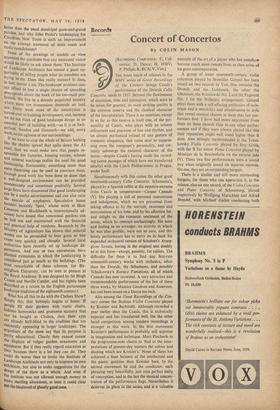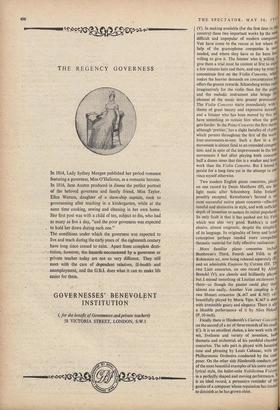Records
Concert of Concertos
By COLIN MASON
[RECORDING COMPANIES: C, Col- umbia; D, Decca; H, HMV; P, Philips; R, RCA; V, Vox.] Tiir latest batch of releases in the HMV series of Great Recordings of the Century brings Casals's performance of the Dvorak Cello Concerto, made in 1937. Beyond the flawlessness of execution, tone and intonation, which were to be taken for granted, its most striking quality is the extreme reserve and the classical character of the interpretation.'There is no assertion, except in so far as this reserve is itself one, of the per- sonality of Casals, who plays with an urbane refinement and precision of line and rhythm, and an almost puritanical refusal of any gesture of romantic eloquence, that come near to suppres- sing even the composer's personality, and cer- tainly submerge the ,national character of the music—despite Casals's having made the record- ing (some passages of which have not transferred ideally) with the Czech Philharmonic in Prague, under Sze11.
Simultaneously with this comes the other great nineteenth-century Cello Concerto, Schumann's, played by a Spanish cellist at the opposite extreme from Casals in temperament—Gaspar Cassado (V). His playing is full of personal mannerisms and indulgences, which we are prevented from taking• offence at by the warmth, sweetness and sensuousness of his tone, and by his affection for, and delight in, the romantic sentiment of the music, which he conveys enchantingly. His taste and feeling as an arranger, an activity in which he was also prolific, were not so sure, and this lovely performance has to carry on its back his expanded orchestral version of Schubert's Arpeg- gione Sonata, boring in the original and doubly so in this form—except, possibly, for cellists. The difficulty for them is to find any first-rate nineteenth-century works with orchestra, other than the Dvorak, the Schumann, and possibly Tchaikovsky's Rococo Variations, all of which Cassado has now recorded. A very attractive and recommendable performance of the last of these three works, by Maurice Gendron and Ansermet, has just been issued on a Decca ten-inch.
Also among the Great Recordings of the Cen- tury conies the Brahms Violin Concerto played by Kreisler and Barbirolli. Although recorded a year earlier than the Casals, this is technically superior and has transferred well. On the other hand competition among modern recordings is stronger in this work. In the first movement Kreisler's performance is probably still supreme in imagination and technique. Marc. Pincherle in the programme-note claims to 'find in the inter- pretations of present-day masters the colour and shaping which are Kreisler's.' None of them has achieved a finer balance of the intellectual and the poetic qualities than Kreisler here. In the second movement he and the conductor, each phrasing very beautifully, just miss perfect unity of conception, and in the last the musical concen- tration of the performance flags. Nevertheless it deserves its place in the series, and is a valuable example of the art of a player who has somehow become much more remote from us than some of his great contemporaries.
A group of lesser nineteenth-century violin concertos played by Bronislav Gimpel has been issued on two records by Vox. One contains they Dvorak and the Goldmark, the other the Glazunov, the Wieniawski No. 2 and the Paganini No. 1 (in the Wilhelmj arrangement). Gimpel plays them with a self-effacing perfection of tech- nique and a sensibility and attentiveness to style that reveal musical charms in them that few per- formers find. I have had more enjoyment from them on these records than in any other perfor- mances and if they were always played like this their reputation might well stand higher than it does. Also strongly recommended is the Tchai- kovsky Violin Concerto played by Ivry Gitlis, with the B flat minor Piano Concerto played by Monique de la Bruchollerie on the reverse side (V). These two fine performances were a sound buy when originally issued on separate records. On one, they are an outstanding bargain.
There is a similar and still more outstanding bargain, for those who can appreciate it, in the release, also on one record, of the Violin Concerto and Piano Concerto of Schoenberg, played respectively by Wolfgang Marschner and Alfred Brendel, with Michael Gielen conducting both (V). In making available (for the first time in tlail country) these two important works by the trlotl difficult and unpopular of modern composer Vox have come to the rescue at last where the help of the gramophone companies is mos' needed, and where they have so far been least willing to give it. The listener who is willing dal give them a trial must be content at first to enial a few minutes here and there, and may be wiser to concentrate first on the Violin Concerto, which'' makes the heavier demands on concentration bUt offers the greater rewards. Schoenberg writes mote imaginatively for the violin than for the piatl°' and the melodic instrument also brings tills element of the music into greater prominence The Violin Concerto starts immediately with a theme of great beauty and expressive intens0 and a listener who has been moved by this WO have something to sustain him when the gets harder. In the Piano Concerto the first thcfl although 'prettier,' has a slight banality of rhythol which persists throughout the first of the work's four-movements-in-one. Such a flaw in a fill! movement is almost fatal to an extended compost' tion. and in spite of the. improvement in the later movements I feel after playing both concertos half a dozen times that this is a weaker and Jesse work than the Violin Concerto. But I intend 00 persist for a long time yet in the attempt to coo' vince myself otherwise. Two modern English piano concertos, played on one record by Denis Matthews (H), are like light music after Schoenberg. John Irelands possibly excepted, Rawsthorne's Second is out most successful native piano concerto—effective, tuneful and distinctive in style, and with sufficiefit depth of invention to sustain its initial popularitY' Its only fault is that it has pushed out his First, which was also very good. Rubbra's is morn elusive, almost enigmatic, despite the of its language. Its originality of form and lyrical conception perhaps needed more compellirq thematic material for fully effective realisation.
More familiar piano concertos include Beethoven's Third, Fourth and Fifth in the Rubinstein set, now being released separately (g) and an admirable. Emperor by Curzon (D). Thy two Liszt concertos, on one record by Alfreel Brendel (V), are cleanly and brilliantly played' but I missed something of. Lisztian excitement them—as though the pianist could play them almost too easily. Another Vox coupling is of two Mozart concertos (K.467 and K.503) yeti beautifully played by Maria Tipo. K.467 is done with irresistible gaiety and elegance. There is alse) a likeable performance of it by Alice Heksck (P, 10-inch).
Finally there is Hindemith's Clarinet Concerti?, on the second of a set of three records of his inu0 (C). It is an excellent choice, a late work with the wit, liveliness and variety of invention, botit thematic and orchestral, of his youthful chamber concertos. The solo part is played with hauntinfi tone and phrasing by Louis Cahuzac, with the Philharmonic Orchestra conducted by the cony poser. On the other side Hindemith conducts one of the most beautiful examples of his more earnest lyrical style, the ballet-suite Nobilissima Visione, in a perfectly shaped and moving performance. It is an ideal record, a persuasive reminder of tV genius of a composer whose reputation has tended to diminish as he has grown older.













































 Previous page
Previous page